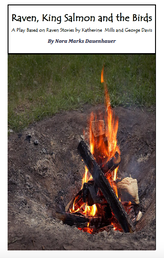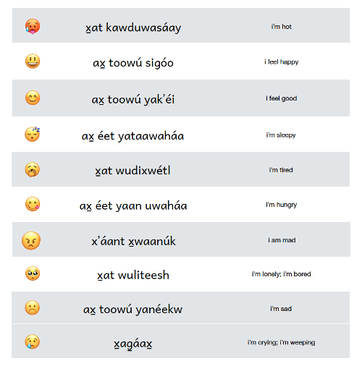Yéil Ḵa Tʼá: Culturally Responsive Lesson Plans
|
Culture bearers share oral narratives that connect to the Southeast Alaska tribal values and help teach important lessons. What better way to explore the tribal value of "lishoogú át kanaylaneek" (tell funny stories) than through Raven the Trickster! Yéil Ḵa Tʼa (Raven and King Salmon) is just such an oral narrative. This oral narrative by Yakwx̱waan Tláa, (Katherine Brown Mills) was adapted into a play by Nora Keixwnéi Marks Dauenhauer published by Goldbelt Heritage Foundation. This oral narrative includes many feeling phrases that align with the Tlingit Culture, Language and Literacy 100 Lingít word list, which the Haa Ḵusteeyí project has adapted.
Listen to this audio recording of Yéil Ḵa Tʼá by Katherine Mills telling in Lingít. Gunalchées, X̱ʼunei Lance Twitchell, for housing these precious recordings of fluent speakers on your website. |
This story has so much to offer culturally and pedagogically that Sitʼ Eetí Shaanáx̱ Glacier Valley decided to create an online Readerʼs Theater artist-in-residency with Ed Shaaḵindustoow Littlefield, Roblin Gray Davis, X̱ʼunei Lance Twitchell and Abel Ryan. Students will
Gunalchéesh all of the individual above, as well as Stephen Blanchett of the Juneau Arts and Humanities Council and Amy Rautiainen and Nancy Lehnhart of the JSD Artful Teaching program for their financial support.
- learn to speak the feeling phrases embedded throughout the story with support from Ed Littlefield
- sign each feeling phrase and character with guidance from Janet Olmstead (JSD Deaf & Blind Educator) and Jinkasee.ee Rose Willard (JSD cultural specialist).
- comprehend the story sequence by understanding key phrases in Lingít
- play language games created by Elizabeth Kent (JSD Integration Specialist), Jinkasee.ee Rose Willard and X̱ʼunei Lance Twitchell (Associate Professor of Alaska Native Languages at UAS)
- assemble formline design puppets created by Abel Ryan, Tsimshian carver and teacher
- bring these puppets to life with Roblin Davis Gray, puppeteer and drama specialists
- package them all in a story bag for every K-5 student at Sitʼ Eetí Shaanáx̱ and Riverbend Elementary student donated by Goldbelt Heritage Foundation.
Gunalchéesh all of the individual above, as well as Stephen Blanchett of the Juneau Arts and Humanities Council and Amy Rautiainen and Nancy Lehnhart of the JSD Artful Teaching program for their financial support.
Culturally Responsive Teaching Best Practices: These three lessons prepare K-5 students for an artist-in-residency culminating in a formline puppet performance of this oral narrative. Every child received a Lingít Language Story Bag containing hands-on activities to engage students and families in the story, including formline puppet templates, script, card games focused on teaching key vocabulary and phrases in Lingít, and links to online resources. For more details on this project click here.
The following Culturally Responsive teaching practices are included in these lessons: use of story, song, movement and call and response. Indigenous artists and language scholars were consulted and involved in each step of the process. The Southeast Traditional Tribal Value of Lishoog̱ú át kanaylaneek (“Tell Funny Stories”) forms the foundation of the unit as told through this raven story.
The following Culturally Responsive teaching practices are included in these lessons: use of story, song, movement and call and response. Indigenous artists and language scholars were consulted and involved in each step of the process. The Southeast Traditional Tribal Value of Lishoog̱ú át kanaylaneek (“Tell Funny Stories”) forms the foundation of the unit as told through this raven story.
Piloting a Language Learning Process
|
This artist-in-residency gives us an opportunity to experiment with the Lingít language learning process. This video outlines the three stages:
|
|
|
Lesson 1: What lessons does this oral narrative teach?
Overview After listening to the cultural specialist tell the oral narrative of Yéil Ḵa Tʼá (Raven and King Salmon) in English, students share what lesson they think the story teaches. Students will practice the tribal values of K’idéin át yisa.áx ka a yáa awuné wáa sá i daa yadukaayí ("listen well and respect what people say to you") by respectfully listening as the cultural specialist tells the story following oral tradition. Students will then share out what lesson they think the story teaches. There is no right or wrong answer, but rather an opportunity for children to share their thinking before learning the tribal value connected with this oral narrative from the Haa Ḵusteeyí unit. Objectives
Activities
Evaluation Students will be assessed when they share the lessons they think the story teaches and why. This formative assessment is grounded in the Project Zero Thinking Routine of See, Think and Wonder in which students need to provide evidence of what they saw or heard to back-up their thinking. Culturally Responsive Teaching Reflection This lesson was very engaging for students. They were excited to share their thinking backed by evidence from the story. As documented in the video above, students made connections to tribal values that they learned previously and each was confident to share their own interpretation and perspective. |
Lorrie Heagy
Subject: Lingít Oral Narratives Grade level(s): K-5 Unit: Yéil Ḵa Tʼa Lesson 1 of 3 Materials List:
Standards Addressed: Cultural Standard A.1
Speaking & Listening Standards:
|
|
Lesson 2: Listening to Our Elders
Overview After listening to the cultural specialist tell the oral narrative of Yéil Ḵa Tʼá (Raven and King Salmon) in English in Lesson 1, students will listen to an audio recording in Lingít of Yéil Ḵa Tʼá by Katherine Mills. To prepare them for the recording, students first will collectively recall as much of the story and its details before the teacher shares the tribal value that was selected for this story: Lishoog̱ú át kanaylaneek ("tell funny stories"). While listening to the recording, students draw an event from the story in their Haa Ḵusteeyí journals that they feel illustrates the value of Tell Funny Stories. Objectives
Activities
connections with the language to the story.
Adaptations Students may move to the songs any way they feel most comfortable. The Google Slide presentation that accompanies the storytelling provides visuals for students to help build more background knowledge and context. Evaluation Students will be assessed when they share their drawings and expain why this event in the story reflects the tribal value of Tell Funny Stories. This formative assessment is grounded in the Project Zero Thinking Routine of See, Think, Wonder in which students need to provide evidence of what they saw or heard to back-up their thinking. Culturally Responsive Teaching Reflection This lesson was very engaging for students because we gave them enough anchors to listen with purpose to the Lingít recording of the oral narrative. They also had something to do with their hands that directly related to their listening task: drawing an event from the story that represented the tribal value of Tell Funny Stories. As documented in the video above, students were eager to share their drawings. |
Lorrie Heagy
Subject: Lingít Oral Narratives Grade level(s): K-5 Unit: Yéil Ḵa Tʼa Lesson 2 of 3 Materials List:
Standards Addressed: Cultural Standard A.1
Speaking & Listening Standards:
|
|
Lesson 3: Wáasá i toowú yatee? How are you feeling?
Overview After listening to the telling and retelling of the oral narrative of Yéil Ḵa Tʼá in English and Lingít, respectively, students will learn feeling phrases listed in the TCLL 100 Lingít word list along with the ASL signs. These phrases are embedded in the script, which was adapted from the oral narrative by Yakwx̱waan Tláa, (Katherine Brown Mills). Gunalchéesh to Jinkasee.ee Rose Willard, X̱ʼunei Lance Twitchell and Yaandu.ein Paul Marks for their work on this. As the script is read along with the Feeling Phrases Google Slide Presentation, students learn each of the Lingít feeling phrases in context of the story.
Activities
Adaptations Students may move to the songs any way they feel most comfortable. The Google Slide presentation that accompanies the storytelling provides visuals for students to help build more background knowledge and context. Evaluation Students will be assessed when preparing to play Gimkit. This formative assessment gives the teacher a brief snapshot of how much the students remember. The teacher speaks each feeing phrase in Lingít without the ASL and looks to see how many students can sign correctly. The Gimkit also serves as a formative assessment using a different medium - emojis and audio recordings. Culturally Responsive Teaching Reflection This lesson was very engaging for students because they learned it prepared them for a puppet performance. They also had choices in how theyʼd like to participate: signer, speaker or puppeteer. Knowing that the Gimkit was the culminating activity of this lesson was also very motivating. Students love these games and work hard to excel in them. |
Lorrie Heagy
Subject: Lingít Oral Narratives Grade level(s): K-5 Unit: Yéil Ḵa Tʼa Lesson 3 of 3 Materials List:
Extension: Google Slide with ASL signs for Key Vocabulary (leads to future lessons on how color is expressed in Lingít: (x̱ʼaan yax yatee or It is like fire" for the color red. Standards Addressed: Cultural Standard B.3
|
Digital Badges: Another Tool for Motivation and Demonstration of Mastery
|
Digital badges have been another motivating tool for demonstrating language mastery. Whether using Flipgrid or Seesaw, students can earn digital badges and be creative and social while doing it. We have created a Badgr account that interfaces with Flipgrid. The results at both Riverbend and Sitʼ Eetí Shaanáx̱ Glacier Valley Elementary Schools have been impressive: over 230 students earned at least one of the six badges. Gunalchéesh to Shawna Puustinen and Christina Sabin for introducing the idea of physical tags on necklaces to give to students. They love them!
|
A Studentʼs Reflections ...
This Zoom session was recorded two months after the performance of Yéil Ḵa Tʼá. If you ever wondered if students are thinking about Lingít oral narratives and sharing the language outside of the classroom, the student in this short video gives a resounding Yes!
|
|



